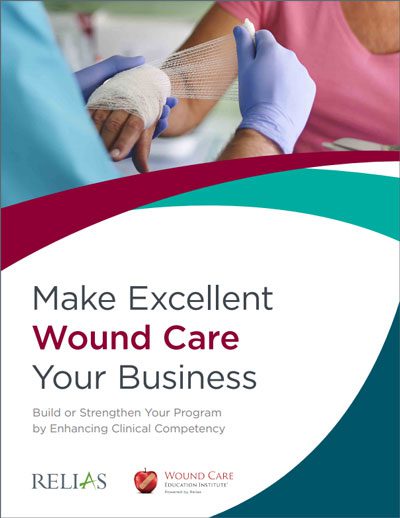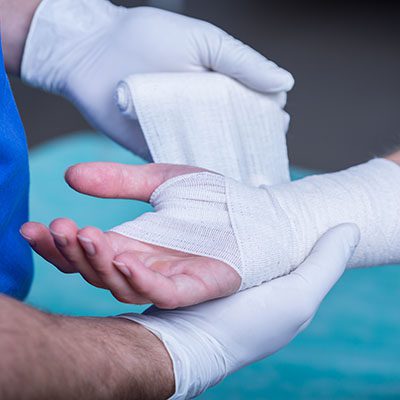Older people are at risk for a variety of health problems, ranging from physical health deterioration to cognitive decline. While the risk factors for these conditions differ, nearly all older people are at risk for pressure injuries. Also known as pressure sores or pressure ulcers, these wounds are more likely when pressure builds on a specific area of the body over time. Repeated pressure exposure on the same area will result in the degradation of the skin’s integrity, literally opening the skin up to infection. Caregivers can take action to prevent pressure sores in older clients and avoid negative outcomes that can follow.
The Centers for Medicare and Medicaid Services (CMS) requires all health facilities in the Medicare program to track and report data reflecting pressure injury development on all clients. As part of CMS programs to promote healthcare quality, quality measures in different healthcare settings report on trends in pressure injury development. CMS assesses financial penalties on health facilities when clients develop pressure injuries in their care.
Guidance on CMS websites includes quality measures focused on preventing pressure injuries and maintaining skin integrity. The quality reporting focuses on settings such as hospitals, nursing homes, inpatient rehabilitation facilities, home health, and more. The Agency for Healthcare Research and Quality’s patient safety tool, Preventing Pressure Ulcers in Hospitals, also provides helpful guidance.
With knowledge and training, caregivers can work to reduce pressure sores among older clients, as well as ailing people of any age. These seven steps are important to prevention:
1. Get your clients moving
Exercise, ambulation, and range of motion exercises promote circulation. And circulation actually helps to prevent the formation of pressure sores, as noted in U.S. National Library of Medicine guidance. Prevention requires much more than simply getting out of bed and into a wheelchair. Pressure sores may develop on the tailbone, hip, shoulders or heels from prolonged sitting in a wheelchair. So ensuring your clients employ variety in their movement is key.
Older people should use wheelchairs when necessary, but caregivers can help them get into recliners or other more-cushioned chairs to relieve pressure. Also, avoid leaving older people in one position in any location for an extended period of time. Preventive steps include repositioning clients when they are lying down or sitting while awake for extended periods during the day.
2. Check the skin often for signs of developing pressure sores
Caregivers should check the skin frequently for signs of developing pressure injuries. A pressure sore may develop in less than a few hours.
For example, have you ever experienced increased soreness and redness on your buttocks while driving for more than an hour or two? If so, you may have developed a Stage I pressure sore. But your ability to move allowed you to recognize the pain and adjust your position to prevent it from progressing.
For some older clients, you must be the one to check and recognize the signs of a pressure sore’s development when performing perineal care, providing showers, or performing other assessments of skin integrity. You must document all such checks as well.
3. Use specialty bedding or materials to reduce pressure
Depending on the needs of each client, specialty beds, such as water or air mattress toppers, or special, cushioned padding, such as heel protectors, can reduce the amount of pressure placed on sensitive areas of the body. These additional materials should not be limited to mattresses or modifications to footwear. Instead, keep the options open for what may and may not be the most comfortable and beneficial to the needs of your older clients.
For example, a memory-foam pillow is great, but it does little good if it is always placed in the same position. Furthermore, soft, pillow-like wedges may be used to help clients remain on their sides while lying in bed between repositioning times.
Some newer beds may suggest automatic turning is available for use. However, these systems do not completely reposition a person. As a result, it is best to use these systems in conjunction with manually repositioning a person.
4. Keep the skin dry and clean
Incontinence is one of the biggest factors associated with the development of pressure sores. When bowel movement or urine stays in contact with the skin, acids and enzymes in them will begin to cause excoriation and degradation of the skin faster than usual. When combined with limited ability to reposition oneself, a client may develop a pressure sore in the perineal area faster.
If the area appears to become reddened, the client may have developed a Stage I pressure sore. When this occurs, it is best to assume the area has been subject to more intense pressures. You can proceed with an appropriate treatment, such as the use of a barrier cream to help prevent further excoriation due to bodily substances. However, the use of a barrier cream does not negate the need for continued repositioning and movement to help prevent worsening of the area.
5. Encourage clients to maintain a healthy diet
The benefits of a well-functioning circulatory system are only as good as the nutrients it delivers. It is important for older people to strive to eat a well-balanced, healthy diet, as a Medscape article notes. In fact, optimizing the nutritional status of a client living with a pressure sore is key to ensuring successful treatment. For your clients living with metabolic disorders, such as diabetes, a healthy diet can go much further than simply preventing or encouraging the healing of pressure sores.
6. Manage chronic health conditions effectively
Chronic health conditions may also impact risk for developing pressure injuries. Any condition that affects the function of the cardiovascular system may result in poor circulation and greater risk for pressure sores, as guidance on Healthline states. As a result, the effective management of these conditions remains critical to preventing the development or worsening of pressure sores.
This may include monitoring fluid intake for those with heart failure, maintaining dietary restrictions for people with kidney disease, or ensuring that medication interactions do not result in poor circulatory function.
7. Create incentives to prevent pressure sores
Caregivers of older adults play major roles in preventing the development of pressure sores, so consider implementing an incentive-based program. This program can use data from your pressure sore tracking measures to provide a reward or recognition to caregivers who maintain repositioning and actively work to reduce the prevalence of pressure sores among those in your care.
Put these steps into action today
Healthcare leaders can take many different paths to reducing pressure sores among their older clients. You could even have a brainstorming session with caregivers about the best ways to knock out pressure sores for your population of clients.
Whether people are receiving care in the hospital, long-term care facilities, or at home, these seven steps can be implemented to prevent pressure injuries. Since it is in the best interest of your organization and the people you serve, start using these strategies to prevent pressure sores and stay informed about the latest evidence-based practices.
Editor’s Note: This blog post was originally published in October 2016 and has been updated.

Strengthen Your Wound Care Program, Enhance Clinical Competency
If you’re interested in building up your wound care program — whether just getting started or aiming to enhance the care you already offer — you’ll need a comprehensive approach to ensure success.
Download E-book →






